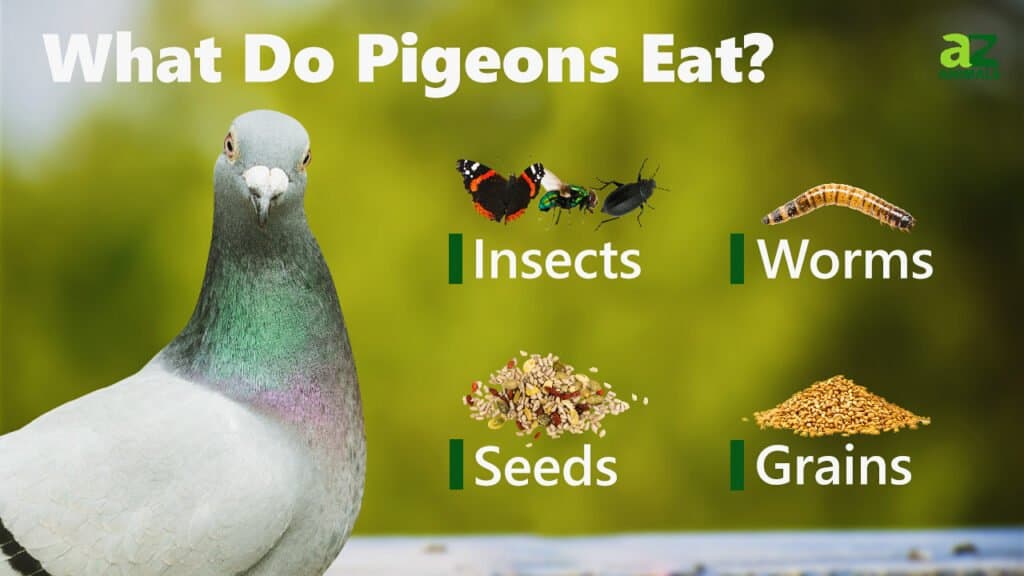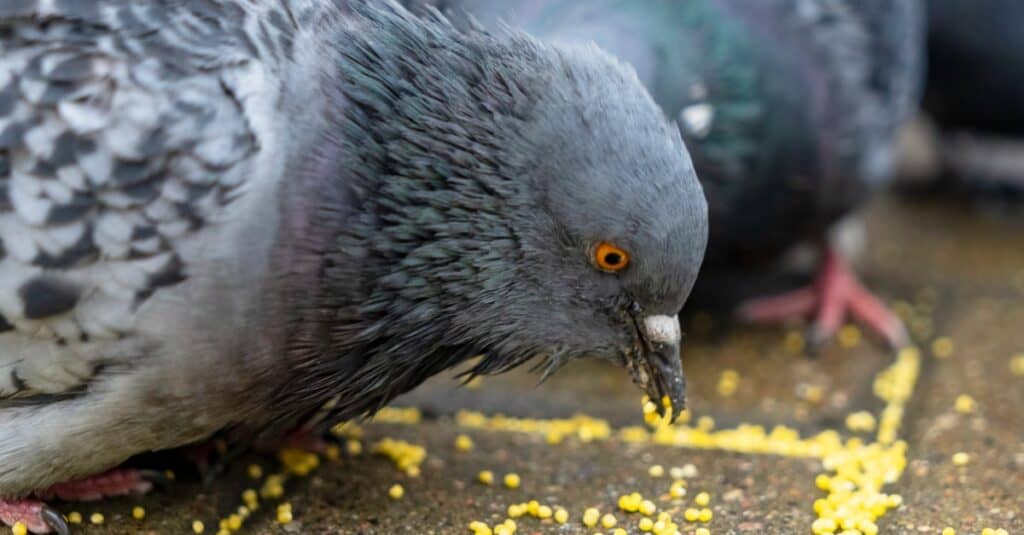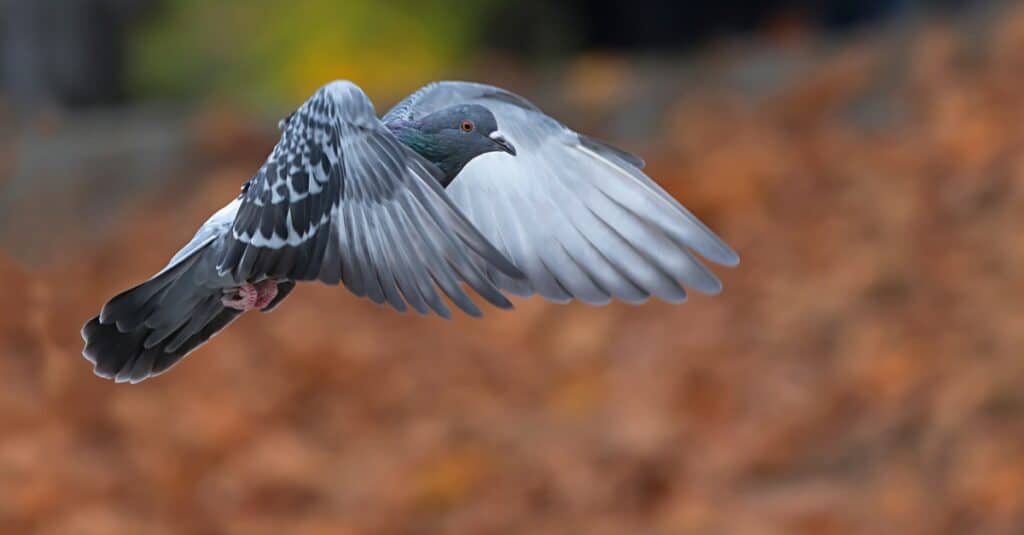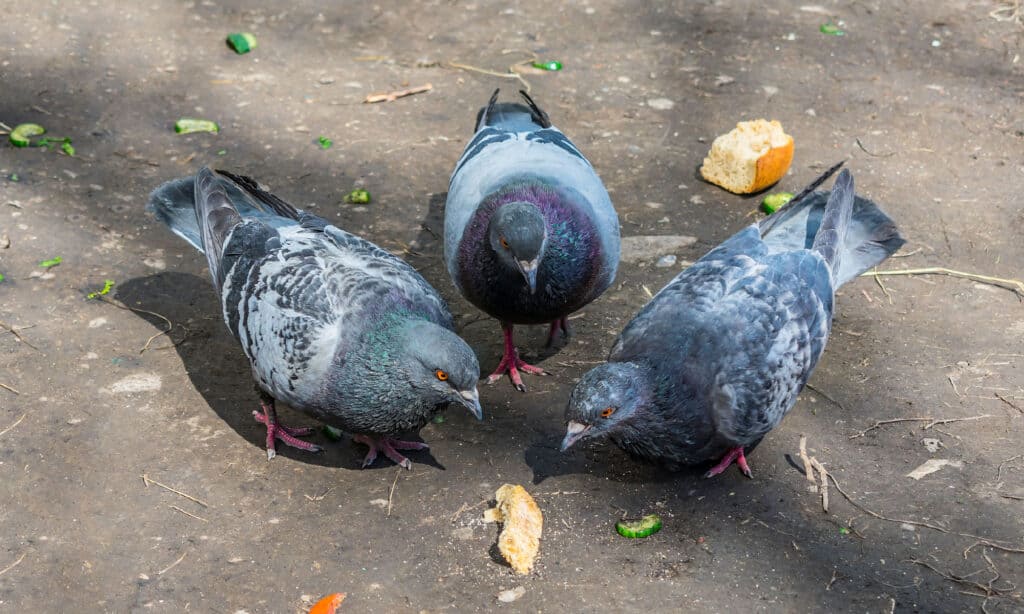
The pigeon is a family of stout-bodied birds with a fleshy beak and large wings. Some of the best-known species can be found congregating near human cities and towns, including the common wood pigeon, rock pigeon, and mourning dove, but there are actually some 340 species distributed worldwide, many of them native to the Asian Pacific region and rarely seen by people. Pigeons are so widespread and varied that it is difficult to summarize anything specific about their diet as a whole, but this article will attempt to cover some general information about what they eat and how they eat it, whether they reside in the city or in the wild.
A quick note on the usage of terms: the English language sometimes makes a distinction between pigeons and doves based on their size. Pigeons tend to be the larger of the two. However, this distinction does not really have a good scientific basis and isn’t even applied consistently. For example, the rock dove is also called a rock pigeon. This article will cover any member of the pigeon family, whether it’s called a pigeon or a dove.
What Does the Pigeon Eat?
Pigeons are sometimes described as true omnivores (meaning they’ll eat both plants and meat; really almost anything they can find). But in practice, almost their entire diet consists of plant matter, including grains, grasses, green leafy vegetables, herbs, weeds, fruits, and berries. They supplement this with the occasional meal of insects, snails, and earthworms.
The composition of the diet really depends on the location. Pigeons located near the tropics tend to eat more fruits than seeds and therefore spend a great deal of time foraging in trees. Many temperate species, on the other hand, obtain the bulk of their nutrients from seeds. The diet of the common mourning dove consists of around 99 percent of seeds alone, including cultivated grains and peanuts. It’s estimated that they consume around 12% to 20% of their body weight every single day. That’s equivalent to around 71 calories on average.
Pigeon anatomy is very well-adapted to take advantage of the foods around them. Heavy seed and grain eaters tend to rely heavily on their gizzards (a special organ located near the digestive system) to grind up tough food. Their intestines are longer to break down and absorb the complex carbohydrates. They’re also much more likely to forage for food on the ground. Heavy fruit eaters, on the other hand, generally have shorter intestines and a thinner gizzard; they also have a greater ability to cling to branches and hang upside down so they are better able to obtain fruits from trees.
Before reaching adulthood, baby pigeons are well-known for feeding on a substance called pigeon’s milk. This isn’t true milk, but instead a semi-solid regurgitated substance extremely high in proteins and fats to help the hatchlings grow to full size. The baby pigeons consume this “milk” within the first few days of life before being gradually weaned to accept seeds and other foods. It may take a few weeks before the baby pigeons are fully capable of digesting the adult food.
Pigeons are thought to play an important ecological role in the wild by dispersing uneaten seeds throughout their environments.
Is Bread Bad for Pigeons?

©iStock.com/Ivan Murauyou
Pigeons can eat bread, but that doesn’t necessarily mean they should. While it might be very tempting and even delightful to feed pigeons with bread as you sit on a park bench, some experts counsel against this practice because it can sometimes create more problems than it solves. There are a few reasons for this. The first reason is that many human-made types of bread may not necessarily contain all of the nutritional value that pigeons require. The second reason is that it might attract other animals and pests besides pigeons as well. Third, it can easily cause overcrowding as entire flocks of birds to congregate together and compete for free feedings. Finally, bread may make pigeons more dependent on human goodwill, which dulls their natural foraging ability (even if they’re just foraging on leftover human food).
If you are intent on helping out pigeons, then it is a better idea to set up a small feeding box in your yard where just a few birds can enjoy the occasional meal at their own leisure.
What Should You Feed Wild Pigeons?
Pigeons should enjoy some combination of wheat, cracked corn, sunflower seeds, sorghum, and millet. In order to maximize the chances of attracting them, you might want to spread out seeds on the ground or put them in some kind of tray or platform feeder on which the bird can easily perch. Dense shrubs or evergreen trees near your yard can serve as a potential nesting site to keep the pigeons nearby. Putting up a nesting cone might attract an entire pair as well. They like to have a birdbath nearby with ledges to stand on.
What Do Pigeons Eat in the City?
Urban pigeons in the city tend to scavenge small seeds, fruits, vegetables, insects, spiders, worms, and even leftover human food. Many of them are specifically adapted for urban environments and differ slightly from their wild counterparts. If you are keeping a domesticated pigeon as a pet, then you might want to offer it a pellet-based diet combined with some fruits and vegetables to meet its nutritional needs. Products labeled as seed mixes are not necessarily the same thing a bird in the wild would eat. They may be deficient in some important nutrients.
What Eats Pigeons?

©N.Z.Photography/Shutterstock.com
For centuries, humans have been the greatest predators of the pigeon. In the 12th century, pigeons were considered a delicacy served to nobility. In the 16th century, attitudes changed, and pigeons were fed to the poor. Jump to the 20th century, and pigeons were seen as pests. Pigeon hunting even rendered the American passenger pigeon extinct.
Pigeons are preyed upon by many others in nature, including birds of prey such as falcons and hawks. The eggs are also consumed by ravens, crows, grackles, domesticated cats, snakes, and rodents.
A Complete List of the Top 10 Foods the Pigeon Eats
Pigeons have a long and varied diet. This is by no means an exhaustive list of foods, but it should give you some idea of what most pigeons eat.
- Seeds and grains
- Grasses
- Weeds
- Green Vegetables
- Herbs
- Fruits
- Berries
- Insects
- Snails
- Earthworms
What Can Pigeons Not Eat?

Pigeons are not able to eat everything and there are certain foods that should be avoided.
©iStock.com/Nikolay Chekalin
Like many animals, there are certain foods that are toxic to pigeons. Whether pet bird or wild birds, these items should never be given to them. Of course, there are certain forbidden foods that pigeons love, and will try to obtain it. Pigeons in urban areas might be more at risk of eating toxic foods since it is much more available to them. One of their favorite items is salt which can dehydrate them. Another is human meats, which may contain certain bacterias to them theat they won’t be able to fight off.
These are additional foods that should be kept away from pigeons:
- Apple seeds
- Avocado
- Caffeine
- Chocolate
- Fats
- Fruit pits
- Garlic
- Onions
- Xylitol
Not only are these items harmful, but there are certain ones that have harsher effets. Items that contain sugar, both in food and drink, can lead to pigeons developing diabetes, and apple seeds contain cyanide which will cause their guts to become irritated.
The photo featured at the top of this post is © iStock.com/Christian Sturzenegger
Thank you for reading! Have some feedback for us? Contact the AZ Animals editorial team.







